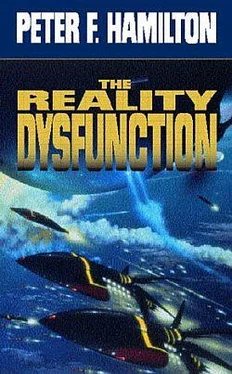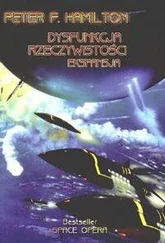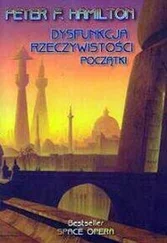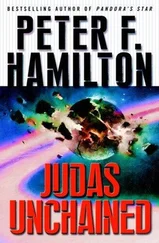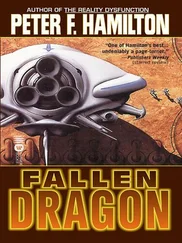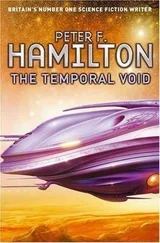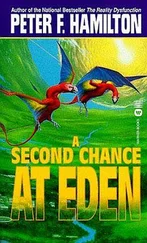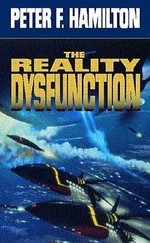Behind the tarnished silver-white disc, three circular ledges stood out proud from the endcap: havens for the bitek starships which came and went with quick, graceful agility. Their geometrical diversity fascinated the entire spaceport, and most of the habitat’s population; observation lounges overlooking the ledges were popular among the young and not-so-young. Mirchusko was where the blackhawks mated and died and gestated. Tranquillity offered itself as one of their few legitimate home bases. Their eggs could be bought here, changing hands for upwards of twenty million fuseodollars and absolutely no questions.
Around the rim of the endcap hundreds of organic conductor cables stretched out into space; subject to constant dust abrasion and particle impact, they were extruded on a permanent basis by specialist glands to compensate for the near-daily breakages. The habitat’s rotation kept the cables perfectly straight, radiating away from the shell like the leaden-grey spokes of some cosmic bicycle wheel. They sliced through the flux lines of Mirchusko’s prodigious magnetosphere, generating a gigantic electrical current which powered the biological processes of Tranquillity’s mitosis layer as well as the axial light-tube and the domestic demands of its inhabitants. Tranquillity ingested thousands of tonnes of asteroidal minerals each year to regenerate its own polyp structure and invigorate the biosphere, but chemical reactions alone could never produce a fraction of the energy it needed to nurture its human occupants.
Beyond the endcap and the induction cables, exactly halfway down the cylinder, there was a city, home to over three million people: a band of starscrapers wrapped around the median equator, five-hundred-metre-long towers projecting out of the shell, studded with long, curving transparencies that radiated warm yellow light out into space. The view from the luxurious apartments inside was breathtaking; stars alternated with the storm-wracked gas giant and its little empire of rings and moons, eternal yet ever-changing as the cylinder rotated to provide an Earth-standard gravity at the base of the towers. Here, Adamists were granted the sight which was every Edenist’s birthright.
Small wonder, then, that Tranquillity, with its liberal banking laws, low income tax, the availability of blackhawks to charter, and an impartial habitat-personality which policed the interior to ensure a crime-free environment (essential for the peace of mind of the millionaires and billionaires who resided within), had prospered, becoming one of the Confederation’s premier independent trading and finance centres.
But it hadn’t been designed as a tax haven, not at first; that came later, born out of desperate necessity. Tranquillity was germinated in 2428, on the order of the then Crown Prince of Kulu, Michael Saldana, as a modified version of an Edenist habitat, with a number of unique attributes the Prince himself requested. He intended it to act as a base from which the cream of Kulu’s xenoc specialists could study the Laymil, and determine what fate had befallen them. It was an action which brought down the considerable wrath of his entire family.
Kulu was a Christian-ethnic culture, and very devout. The King of Kulu was the principal guardian of that faith throughout the kingdom; and because of bitek’s synonymous association with Edenists, Adamists (especially good Christian ones) had virtually abandoned that particular branch of technology. Possibly Prince Michael could have got away with bringing Tranquillity into existence; a self-sustaining bitek habitat was a logical solution for an isolated academic research project, and astute propaganda could have smoothed over the scandal. Royalty is no stranger to controversy, if anything it adds to its mystique, especially when relatively harmless.
But the whitewash option never arose; having germinated the habitat, Prince Michael went and compounded his original “crime” (in the eyes of the Church, and more importantly the Privy Council) by having neuron symbionts implanted enabling him to establish an affinity bond with the young Tranquillity.
His final act of defiance, condemned as heretical by Kulu’s conclave of bishops, came in 2432, the year his father, King James, died. Michael had a modified affinity gene spliced into his first son, Maurice, so that he too might commune with the kingdom’s newest, and most unusual, subject.
Both were excommunicated (Maurice was a three-month-old embryo residing in an exowomb at the time). Michael abdicated before his coronation in favour of his brother, Prince Lukas. And father and son were unceremoniously exiled to Tranquillity, which was granted to them in perpetuity as a duchy.
One of the most ambitious xenoc research projects ever mounted, the unravelling of an entire species from its chromosomes to whatever pinnacles of culture it achieved, virtually collapsed overnight as its royal treasury funds were withdrawn and staff recalled.
And as for Michael: from being the rightful monarch of the seven wealthiest star systems in the Confederation, he became the de facto owner of a half-grown bitek habitat. From commanding a navy of seven hundred warships, the third most powerful military force in existence, he had at his disposal five ex-navy transports, all over twenty-five years old. From having the absolute power of life and death over a population of one and three-quarter billion loyal human subjects, he became an administrator of seventeen thousand abandoned, shit-listed technicians and their families, resentful at their circumstances. From being First Lord of the Treasury dealing in trillion-pound budgets, he was left to write a tax-haven constitution in the hope of attracting the idle rich so he could live off their surplus.
For time evermore, Michael Saldana was known as the Lord of Ruin.
“I am bid three hundred thousand fuseodollars for this excellent plant. Really, ladies and gentlemen, this is a remarkable specimen. There are over five intact leaves, and it is of a type never seen before, completely unclassified.” The plant sat in a glass vacuum bubble on the auctioneer’s table: a dusty grey stalk, sprouting five long drooping fern-like leaves with frayed edges. The audience gazed at it in unappreciative silence. “Come along now, that protuberance at the top may well be a flower bud. Its cloning will be such a simple matter, and the genome patent will remain exclusively in your hands, an incalculable font of wealth.”
Someone datavised another ten thousand fuseodollars.
Joshua Calvert didn’t try to see who. This crowd were experts, facial expressions like poker players running downer programs. And they were all here today, packing the room, there wasn’t a spare chair to be had. People stood four deep around the walls, spilling down the aisles; the casuals, billionaires looking for a spark of excitement, the serious collectors, consortium bidders, even some industrial company reps hoping for technological templates.
Here because of me.
Barrington Grier’s outfit wasn’t the largest auction house in Tranquillity, and it dealt in art as much as Laymil artefacts, but it was a tight, polished operation. And Barrington Grier had treated a nineteen-year-old Joshua Calvert who had just returned from his first scavenging flight as an equal, as a professional. With respect. He had used the house ever since.
The bidding room was on the fiftieth floor of the StMary’s starscraper, its polyp walls overlaid by dark oak panelling, with velvet burgundy curtains on either side of the entrance arches and thick royal-blue carpets. Elaborate crystal lights cast a bright glow on the proceedings. Joshua could almost imagine himself in some Victorian London establishment. Barrington Grier had told him once that was the effect he wanted, quiet and dignified, fostering an atmosphere of confidence. The broad window behind the auctioneer spoilt the period effect somewhat; stars spun lazily outside, while Falsia, Mirchusko’s sixth moon, slowly traversed the panorama, a sliver of aquamarine.
Читать дальше
